E-Archive
Good Vibrations
in Vol. 14 - March Issue - Year 2013
Are You Being Served?

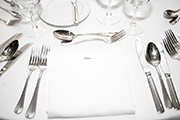
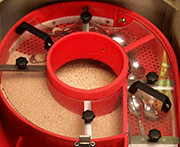
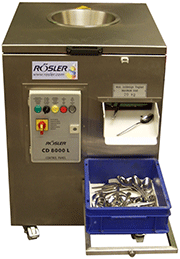
CD 8000 The drier/polisher provides germ-free and stain-free drying of cutlery utensils, where clean but still wet cutlery is taken directly from the dishwasher and loaded rapidly into the inlet point of the CD drier, entering a one-pass process chamber (approx. 30 seconds) where polished dried cutlery is automatically separated from the special granular drying media and collected in a tray, ready for service.
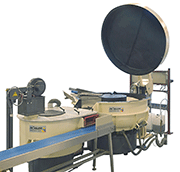
RCD wet polishing and drying system
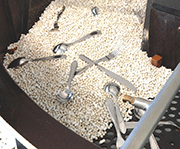
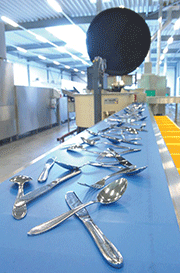
Automation in larger kitchens
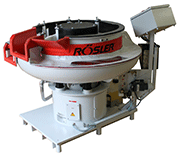
Duel machine
Are you being served with cutlery that has water stains from the automated dishwasher? Nobody wants to see unsightly water stains (spotting) on their cutlery when dining out.
First impressions count, so all quality restaurants take great pride in cleanliness and presentation, while on one hand, the menu might be the obvious first consideration for the restaurateur, it is equally important that the cutlery and other utensils are presented in the best possible condition so when we arrive at the dining table we get the necessary "feel good factor".
We often see the table waiter wiping/polishing cutlery with a cloth as they lay a table; they are generally removing the water stains that the dishwashing machine deposits after the final rinse cycle, in fact, many restaurants and catering establishments employ kitchen staff to wipe/polish each individual piece of cutlery by hand as it comes out of the dishwasher.
Water staining or spotting can be the result of water hardness or the minerals in the rinse cycle water. Additives and filters can help minimise the staining/spotting issue, but in a high volume top-class kitchen, such solutions are costly to operate, monitor and maintain.
The mostly harmless but unsightly residual water stains from the dishwasher are very difficult to remove once they have dried on the surfaces, so in practice, the cutlery is normally taken from the dishwasher wet and then dried/polished by hand. Although hand drying/polishing with a cloth works perfectly well, it is in fact quite an expensive and inconsistent operation, typically, an individual can hand-polish up to a maximum of 400 pieces of cutlery per hour whereas a vibratory cutlery polishing machine (CD) can handle up to 50 times this amount (depending on machine size).
It should also be noted that using a hand cloth is very subjective: how long the same cloth is used before being replaced, or more worryingly, before bacteria builds up and is transferred to the cutlery.
In order to be sure that all cutlery is always presented to the diner in tiptop hygienically clean and polished condition, the vibratory machine and process has been adapted for use in the large kitchens of hotels, restaurants, airline catering facilities, theme parks, cruise ships etc., and has proven to be a wonderful cost-effective solution to an age-old problem.
Machine key features and benefits:
No manual wiping/drying/polishing
Consistent stain-free polished finish
Improved polished finish (when the CD machine is used frequently)
High quality/High output
Easy to operate
Damage free
Continuous operation (easily automated)
230 volt low energy
Complete stainless steel
Compact design (manufactured for kitchen use)
Easily moveable on wheels
UVC lamp compliant to EU hygiene standard 93/43/EWG
CE-certified
Easy to clean and maintain the machine
Vibratory finishing machines can also be used for washing cutlery
In addition to the CD cutlery polishing machines that are used primarily to replace hand wiping and polishing using a cloth, vibratory machines (RCD) can also be used for the washing/polishing and drying of large volumes of cutlery, for example, catering companies that provide a complete offsite service for marque weddings or similar events often have the utensils returned that are contaminated with "dried" food particles, and even the most efficient industrial dishwashers can have difficulty removing dried-on food deposits, especially from the gaps between the prongs of a fork.
Using an RCD-type cutlery cleaner charged with pure porcelain media, the non-abrasive (wet) mass gently abrades the surfaces of the utensils removing any dried-on food particles while at the same cleaning and polishing all contact surfaces.
As the RCD machine employs a wet process, a separate free-standing dryer is required, and normally the machines are linked together with the complete cycle being automated with loading conveyors and unload conveyors.
Features and benefits:
Elimination of manual labour
Provides considerable cost-savings
No pre-cleaning of cutlery required
Replaces all the functions of the tradition dishwashing machine
Gentle mechanical action replaces the necessity to use heated water (energy saving)
Easily automated
Consistent high polish finish
Manufactured to hygiene standard DIN 10510.2008.06
Also available space-saving machines that incorporate the wet polishing process chamber and the drying chamber in one free-standing design.
While you may not think that there is a place in a kitchen for a vibratory mass finishing machine, we continue to find many different applications.
Good Vibrations
by Paul Rawlinson, Contributing Editor MFN
Tel. +49.9533.924 647
Fax +49.9533.924 601
E-mail: P.Rawlinson@rosler.com



























